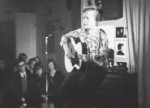December seems like a good time to feature “Who Knows Where the Time Goes?” one of the best musical products of the mid-sixties folk revival. A short and simple languid reflection on the natural world and the timeless nature of relationships, it was written by 15 year old English lass Sandy Denny (1947-1978). The song might have remained a poem in a school girl’s notebook but then a couple of struggling American songwriters traveled to England and three musical lives intertwined with memorable results.
New Yorker Paul Simon (b. 1941) arrived in
England
in 1965. He had been writing songs and performing since junior high school,
often with his friend Art Garfunkel. In
1957 they had a regional hit single released under the non-Semitic names
(selected by their record company) of Tom & Jerry. Afterwards Simon continued to write and
record but with little success. By 1963 he and Garfunkel were hanging out in New York’s Greenwich Village
folk scene. Simon was listening to and learning from Dave Van Ronk and Tom
Paxton and he began writing folk-style tunes. In
early 1964 the duo got an audition with Columbia Records
and signed a contract to make an album. Simon and Garfunkel's first LP, Wednesday Morning, 3 a.m., was released
in 1964. It featured just their two voices and Simon’s acoustic guitar. Its
tracks included traditional folk tunes, covers of tunes by other folk
musicians, and some of Simon’s own songs. The record didn’t sell and Simon
moved to England
to pursue a solo career.
Jackson C. Frank (1943 – 1999) was from upstate New York. He used an insurance settlement to finance his trip to England in 1965. He had survived a fire at his elementary school which killed 15 classmates and left him with burns over 50% of his body. A teacher had given him a guitar to help in his rehab, and he eventually began performing in the New York area and then cashed in his claim and joined his friend Paul Simon overseas. The two musicians performed as solo artists in clubs throughout England and both made records. Simon’s was called “The Paul Simon Songbook” and Frank’s was simply titled “Jackson C. Frank” and was produced by Simon. Both musicians also met significant women. Simon fell in love with Kathy Chitty who inspired a number of his compositions. Frank met and dated a teenage nursing student who wrote music. When he heard her sing he encouraged her to change career plans.
Sandy Denny had studied classical piano as a child and learned traditional British folk songs from her grandmother. She sang and wrote songs but didn’t think of a career in music until she met Jackson Frank. Their romance didn’t last very long but inspired by Frank she left nursing and enrolled in an Art College. She began performing on the local folk club circuit and by late 1966 she began appearing in major English folk venues and on BBC folk music programs. In 1967 she made her first two records; first with Alex Campbell and then with Johnny Silvo. The songs that she sang on those records were mostly traditional pieces but two had been composed by her ex-boyfriend Jackson Frank.
While Denny was performing in a London club a member of the acoustic folk pop band Strawbs heard her and she was invited to join the band. She recorded one album with them but it wasn’t released until the early 1970’s, after she became well known. The album includes the first recording of "Who Knows Where the Time Goes?” (The CD re-issue includes two versions; the original with acoustic accompaniment and an orchestrated take).
Even before Denny’s own recording
of the song was released, a demo she had made found its way across the pond to Judy Collins. Impressed with the composition’s imagery and
inherent wisdom Collins recorded it as the title track of her own album
which was released in 1968. That was to be the first of many subsequent covers including ones by Lonnie Donegon, Mary Black, Eva Cassidy, Charlie Louvin, Nanci Griffith, Nina Simone, Nana Mouskouri, Matthew Sweet, and 10,000 Maniacs among others.
About the same time that Collins was recording Sandy’s song, Fairport Convention was rethinking its modus operandi. Until then the band had been inspired by American singer-songwriters and by San Francisco’s jam bands. When their lead singer quit, Fairport conducted replacement auditions but they really had in mind Sandy Denny. Band member Simon Nicol said that she stood apart from the other singers "like a clean glass in a sink full of dirty dishes” and according to their manager Joe Boyd: “We knew we were actually auditioning for her.” Sandy signed on and brought with her the British folk repertoire that she loved. In her short tenure with Fairport Convention the band became the very definition of British folk-rock. In 1970 she left to form her own band Fotheringay and eventually to also record solo albums. She died in 1978. Drinking one day while vacationing with her family, she fell and hit her head. Her straitlaced parents, with due English propriety, were embarrassed by her inebriated condition and didn’t take her for medical treatment. After suffering headaches for a while she died from a cerebral hemorrhage.
Frank’s is also a tragic tale.
Neither his insurance settlement nor his musical expression could hold his Promethean demons at bay and his mental health deteriorated as he began to display all
the symptoms of clinical depression. Moving back from England to Woodstock,
New York, he married and had a
son who died from cystic fibrosis. That loss resulted in a complete emotional
and mental breakdown and he spent the 1970’s in and out of care facilities only
managing to record a handful of new songs. Sometime in the 1980’s he traveled
to New York City (in search of Paul Simon) where he ended up living homelessly,
getting shot in the face in a random act of violence, and being admitted
intermittently to institutions where he was treated for paranoid schizophrenia.
He spent the last years of his life in a care facility in Woodstock and died of
pneumonia at age 56.
Although it turned out to be the only official album released in his lifetime and it never achieved any commercial success, “Jackson C. Frank” with its understated melancholy, mournful content influenced many other performers including Nick Drake, Al Stewart and Marianne Faithful. And were it not for Jackson Frank, Sandy Denny’s career in the medical profession might have come to fruition; she would have been a nurse with an old notebook containing some extraordinary, but unheard lyrics.
For Sandy Denny time went all too soon, for Jackson Frank probably not soon enough.
Paul Simon of course went on to larger than life success with Art Garfunkel and on his own, and his experiences in England were integral to his future accomplishments. Performing throughout England he was exposed to a wide range of musical influences including folk musician Martin Carthy and finger picking jazz guitarist Davey Graham. His own songwriting became infused with England’s traditional music, and the peculiarities of English life found its way into his compositions. It was a very fertile time for songwriting.
Back in America Simon & Garfunkel’s producer Tom Wilson saw the success that The Byrds and Bob Dylan had when they turned on the electricity so he overdubbed guitar, bass and drums on one track from Wednesday Morning and released it as a single. Both Simon and Garfunkel were initially upset with Wilson’s meddling in their art but then the single, “The Sound of Silence” became a hit record. Simon returned to the States post haste and the duo reunited to tour and record again. Their next two albums Sounds of Silence and Parsley, Sage, Rosemary & Thyme were both saturated with Simon’s England. They contained re-recorded songs from The Paul Simon Songbook, songs about his experiences there, as well as a Davey Graham composition and a Martin Carthy arrangement of the traditional English song "Canticle." Simon’s exposure to English folk music and musicians had lasting effect upon his songwriting sensibility, inspiring compositions of delicate and articulate beauty. These two Simon & Garfunkel records catapulted them into stardom, but more significantly they were the first step in his own evolution toward the world music that he eventually embraced 20 years later.














